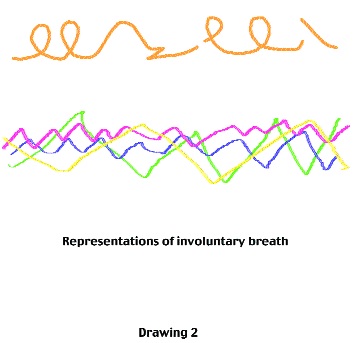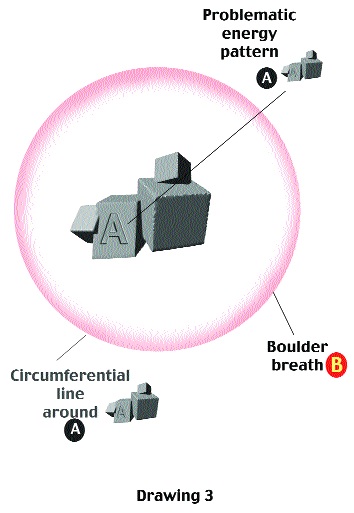Positive Health Online
Your Country

Trauma Energetics: Working with the Breath
listed in energy medicine, originally published in issue 80 - September 2002
Letting Go
When I first began breath meditations, I would follow the directions of my teachers, and they would help me to breathe in the universe and breathe it out. I could hold focus on this objective for moments at a time, but I soon became exhausted and my attention would wander. Additional data in my 'scan' intruded upon the stated objective and quickly overwhelmed the process. When I asked fellow breathers how they were doing, they shrugged their shoulders and reported that they were equally confounded.
I had been meditating, sort of, for years, including summers spent since childhood in a Quaker community whose Friends Meeting services featured silence. I had taken on transcendental meditation in the 1960s, and my instructors seemed hapless in their ability to help me deal with the inner process that a mantra evoked in me. I was advised to return to my sitting and hang out with what came up, and then to let it go.
Figure 1 – A representation of the
energetic portrait of brain/mind/body
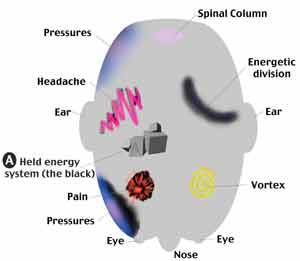
My system was too problematically active for this strategy. Forced to desert it when it made me ignore urgent, perhaps important information, I became discouraged. I found many others were, too. If we considered ourselves as self-scanning organisms, we had trouble discriminating what was important in the scan from what was not, and how to focus on or transmute those differences.
I drifted in and out of meditation practice but never found teachers who would or could instruct me on my own terms, i.e., the terms I was facing within myself. They kept telling me to go to some inner place other than where I was, or, once centred in the present, to do something: they advised me to "Let go" rather than "Watch your brain let go". Intuitively, I felt that these teachers were very right and yet, somehow, very wrong, and the distinction I drew around this issue of intentionality and witnessing became central to what I subsequently discovered.
Redefining Brain
In the early 1990s, with the help of insights developed over 30 years of focus, I consolidated my lifetime study of trauma. I developed Trauma Energetics(tm) (TE), a non-intentional modality for evoking the self-healing powers of the brain.[1]
Over time, I absorbed a 'cosmology' which proposes that energy flows from source, the beginning of all things, and becomes particulate, and that those transitional energetic fields are causal - they are the sites where experience can be seen to start on its way into the densifications of Fflesh; and that if I could bring awareness to the energetic, the particulate levels of experience would revise, beyond what Anthony Deavin refers to as formative mind.[2]
I developed a revised vocabulary to describe and foster these energetic insights, and so I came to call the narrative incarnation of source intelligence, brain, meaning the total neurochemistry of organization characterized in the physical brain and its neurochemical extensions. I found it useful to remind 'consciousness' that it was an expression of neurochemistry, something in the enthralment of being and doing that we easily and often disastrously overlook.
So, from a point of communication, I asked clients to consider themselves as neurochemistries, which, of course, we are. This strategy shifted classical ordinary thought and its vocabulary out of their usual dead-end trajectories; and in a way it critically objectified the scanning process of the brain as a literal, even fundamentalist experience, making it possible to observe without judgement and with appreciation.
Using these and other verbal and imagery devices, I attempted to access the energetic reality, returning brain to its causal, preverbal levels. With selective but non-intentional awareness, my clients and I could effect changes at the particulate levels of incarnation of spirit where the energy becomes particle, the particle becomes neurochemistry, and the neurochemistry becomes physiology and psychology.
I discovered that the deepest trauma sites are expressed in those parts of our neurochemistry that over time remain resistant to other modalities such as psychotherapies, yoga, allopathic medicine, and other healing arts. Previously stuck, my clients could get movement and the resolution of these unresolved trauma sites and their neurochemistries through focus on some aspect of their internal scan energetically represented by colour and shape; these form/patterns record various phases of trauma resolution, starting with shock. I discovered a method for locating shock at an energetic and causal, rather than symptomological level. Some people with greater experience than I thought I was working at subtle body levels, though other specialists who experienced TE said the territory I was exploring was different and unexplored.
In this approach I ask the client to draw or describe the energetic portrait of the brain or other areas of the mind/body without ideas, emotions, sometimes even without kinaesthetic sensations. What emerges is a landscape/weather map filled with shapes and energetic statements of some aspects of the entire human system (see Figure 1).
I discovered that the critical colour stating where the brain itself is in residual shock is black. As in physics, black is where there is no movement. When the dense, hardened forms of the black dissolve, colour or movement returns, reducing or eliminating the narrative symptoms that plague suffering consciousness. In this sense, the artistic insight that black contains all colours is confirmed by the progression out of no movement into movement and colour.
The black has a number of qualities that can be internally sensed and witnessed as held energy. When the client focuses on the black merely as held energy, without physical or emotional narrative, the held-energy system begins to move, transmute and resolve. The result is often a dramatic reduction of symptom, pain, personality problems, addictions, and the like.
I wrote Trauma Energetics: A Study of Held-Energy Systems,[3] consolidating the initial insights, and I waited about a year before I could persuade someone I trained to do a session with me for myself. I naively discovered the modality's power and potential for clarity. When I worked with a client, I somehow knew what the black was and could sense and see it, and identify the appropriate next place to focus. When doing TE for myself, I had difficulty, particularly if I applied the technique to myself, independent of a supervising practitioner.
Trauma Takes Our Breath Away
Then, a few years ago, I realized that trauma takes our breath away. The sites of held energy, which I and my clients scan, are predominantly experienced as shallow breathed and oxygen depleted, sometimes to the point of suffocation. Attempting to resolve my own traumata independent of a supervising practitioner, I realized that I could not easily scan for the black. But at least I could scan my own breath and seek out the sites of shock recorded in its shallowest sequences. All I had to do was witness them, this in an area whose mortal implications would normally incite anxiety.
I began to scan my own breath, again without intention, watching how it assembled itself, how unruly, fragmented and disorganized it could be, how there were times when I was lucky to have a unified sequence, much less a complete one. This focus upon the disorganized orchestra of my breathing process changed everything.
Whereas, before, I could not sustain breathwork, now I could not stop. My whole day became a waking meditation, focused on what was happening with the breath as it fashioned itself in my awareness. At the airport, a friend noted, "You have spent much of your life studying the Greek classics. How wonderful for you to be now for the first time visiting Athens."
"I don't care where I am, as long as I can breathe", I replied, as my friend's eyebrows rose.
In my pursuit of the black, unwittingly I had reinvented the alchemical wheel; I later found out that the early alchemists called the black the negrido. In my process, I saw that the black and lack of oxygen were two hallmarks of the site of trauma. That site must be addressed energetically if the deepest traumata are to be resolved. By examining the breath, I could discover the sites as well as with the black; and, better yet, the client and I could move effectively back and forth between these two modes, accessing the causal levels of why people had difficulty letting go of stressful patterns.
If a change expressed in psychological or insight levels did not also occur in the breath, it probably would not be sustained. The black of held energy is potent and internally experienced as risky; no brain in its right mind will go to a place, even in its own system, where there is compromised oxygen. I could roughly see how the compromising of the breath in the system could result in drastic curtailments of functioning, and how disease and immunity weaknesses could be sponsored at such sites. The Russian research on the relationship between cancer and oxygenation slid into understanding, as did other similar strategy studies.
If the immune system were to be reoxygenated at some 'institutional', causal level, all kinds of old and new balances could be achieved. But why did the presence of deep breathing not necessarily lead to resolution of the trauma? All we needed to do was to take some systematic breaths and everything should be all right, right?
My alchemical understanding of the black showed that the energy was at the interface between so-called spirit and so-called matter. In incarnation strategy, the densification of the soul into energy, into sub-molecular, tissue and organ systems could be observed directly at the energetic level. It could be observed in the breath as well, which had particularity as well as wave-like aspects.
I found that clients perform all sorts of quasi-superstitious manoeuvres with their breath and with their intention in order to deal with these deoxygenated places. To get the changes where the changes needed to occur, there was no point in looking at the voluntary breath; the regular, autonomic, involuntary breath offered an avenue into the trauma sites which were declaring themselves ten times a second for resolution through and within each breath. Thus I did not teach new ways of breathing, as in taking the client to a kind of special amusement park; rather, I escorted clients to the breaths they had, each time asking for involuntary breath as our baseline observation point as means to that end. What they showed me were systems as fragmented and precarious as my own.
Drawing the Breath
Using pencil and paper, I came to ask the client for an initial graphic presentation of an ordinary breath, which, when one comes to think of it, is not easy to do (see Figure 2). How do we draw our breath? And, furthermore, if we use words we can only very roughly approximate this very complex preverbal experience. I had not been prepared by any of my teachers for this complexity. Starting from scratch, it took a while for me to refine the scan into in- and out-breaths, focusing on the important transitions between the in and out and out and in breaths, which meditators have been observing for generations. These strategies evolved as the client and I searched for ways to acknowledge and not interfere with the breath.
As we do with the black, our approach is to witness selectively. I find this to be essential to the full resolution of the held neurochemistry we seek. Breathing into the pain, sending light into the black, interpreting emotional states, all involve some intention, which is fine when they work. But the clients who come to me have been frustrated by these approaches because their patterns don't change or they revert.
Picking Up the Mailbag
The trains in the American Southwest race through small towns and a special hooked arm device at the side of the mail car allows the high speed train to pick up the local bags of mail without slowing down. This is what the brain offers as it scans its self-sustaining breath process. I ask clients to observe these retrieved forms of the breath as forms, and to focus directly at those sections that brain describes as dysfunctional or not smooth enough.
"What does brain say needs to happen here?", I ask, using brain as a generic term to mean the entire intelligence system, including its energetic and neurochemical basis. And the client reports something like, "It needs more balance, or more evening out". We then take brain to the problematic site in the breath and re-examine it, or we take the mailbag of its dysfunctional sequencing, as it were, and begin to work with the graphics of it. In this latter phase, the black soon appears, and we are off and running again. After some sequential attention, we return to the breath to see what changes have occurred. The results are often dramatic, and often bring about healing vortexes or crises or similar neurochemical shifts resulting in greater clarity and a sense of profound evening, deepening oxygenation. By focusing at these energetic levels, the client can sense immediate changes at the physiological level.
Clients often are used to intentional rebirthing or yoga-type breathing protocols to bring the brain to these usually early developmental sectors. I caution against hyperventilation and keep the client observing where the breath is, rather than where it could be. Even with experienced meditators, I find that staying with the complex and traumatically impacted breath we have inspires a high vibratory state, which in turn immediately brings forward for resolution the deoxygenated patterns surrounding traumatic shock; and that the shock often appears to register prior to active lungs, i.e., in prenatal experience.
It was this sequence that initially devastated my early attempts to do breath meditation. It perhaps led my teachers to proffer, "Observe the breath" but not to tell me to describe the results or where to focus specifically within those results. Nor would they say what I might expect, or that the experience could be shared point by point with them. I was left alone to piece together whatever I could, devil take the hindmost. In those moments when I sensed no single breath, but rather fragments barely held together by chewing gum, I thought the directive to "Observe the breath" either ignorant, sadistic, or some Zen threshold initiation to enlightenment.
Re-centring
TE work offers a unified strategy about trauma. Trauma refers to anything that knocks us off our centre, and that in order for rebalancing change to last, that off-centre position must reset itself at a causal level without intention. A concomitant idea is that it is possible to watch the resolution internally at an energetic level, thereby being able to identify significant change, or the lack of it. With my clients, the imagery that evolves is like segments of solid geometry and cartoon animation.
The breath has structure, as well as location, though that is not so easy to define. I have trained clients to witness the edge of the breath to discover the surface of the lining of the lungs, where lungs and air interface. Here, it is possible to sense areas of lung surface as in shock.
Case Study - Gloria
Gloria, a deeply anxious client, suddenly developed an apparently narcoleptic process wherein she would suddenly collapse into unconsciousness, then return to upright and regular conversation, then, moments later, slump over. Her life thus totally disrupted, she had to crawl into my office wearing a head-protecting helmet. We conducted the session on a floor mattress.
Asked whether she could hear me during the 30-second slump moments, she said she could. Having trained her to watch the edge of the breath, I asked her to sense the ratio of oxygen intake and carbon dioxide outflow, whose imbalance led to a collapse into a dormant, rebalancing mode. I talked her through two of these moments, and on the second one she awakened with a startled look. "There is oxygen coming in, but the carbon dioxide exhaust gets backed up", she reported. "Nothing is going out. How can I change that?", she asked.
"I don't know", I replied. "But maybe your system can work on it. I don't think intention will help, but perhaps you can focus specifically on the energetics of the sites we observed." The next day she returned, striding helmetless into the office; she reported that after some focusing, the pattern had rebalanced. To this day, some years later, she reports that the pattern has not recurred.
The lining of the lungs at the air/alveoli interface encompasses a huge number of agencies and vectors. The oxygen is, as it were, mail coded specifically for delivery into specific inner sites in the body, depending upon declared need and overall systems analysis by brain. If the respiratory system is in shock, entire inland regions are compromised, including immunity and endocrine systems. If these early alveolar sentinels are compromised by shock, then they do not function well and, with them, inland systems lacking clear oxygen supply, which is not just rendered as numbers of oxygen molecules, but as vectors of information.
Going Crazy
The most deliberate of the strategies I have devised so far involves locating some severe site of deoxygenation, some impossible dead-end place in the energetic which cannot climb itself out of stolidity or morbidity into the classic source radiance. I ask the client to draw interiorly a line around this phenomenon, including all its problematicity (see Figure 3), then invite witnessing an involuntary regular breath and breathing up to the line, but not into the situation. In the old Reichian days, with some considerable, but not predictable success, we used to 'breathe into the pain', or in other similar ways rescue the besieged castle by directly bringing in new supplies.
But that is not what we now do.
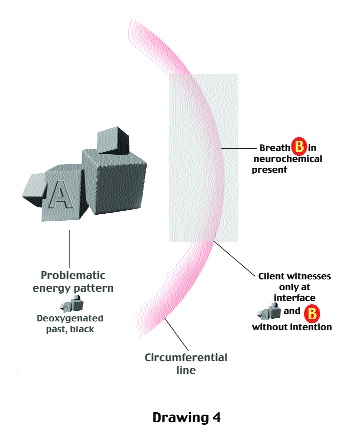
There are two time-neurochemistries at work here (see Figure 4). The first (A) states the early, unresolved, deoxygenating trauma site, going back to significant early, spindle trauma stages in development. The second (B) takes place in the neurochemical present, where there is no umbilicus wrapped around one's neck, nor a mother and infant who are drugged by natal anaesthetics. The client focuses on the graphic sense of the impossible A, and simultaneously brings ordinary involuntary current breath up next to but not into the pattern. I usually name the current breath after the town in which the session is taking place ("Take Boulder 2002 breath...").
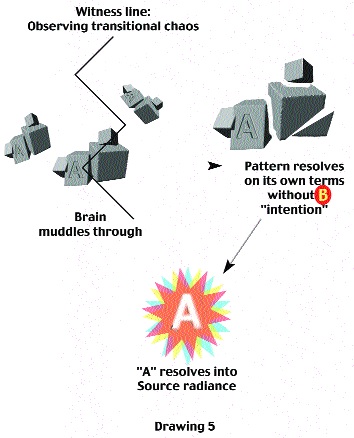
Using the graphics, we juxtapose the two and the client remains focused on the graphic midline between A and B, witnessing only. Usually, black appears on this line, and what results is a series of disordered moments as the brain recalculates the two modes in an English 'muddle-through' sort of way, with tectonic shifts and realignments quickly occurring (see Figure 5). Thus tossing the cat in the air, the oxygen will land brain on its feet automatically, at a systemic causal level, so that no will is needed to solve the problem. All the client has to 'do' is witness the random animation of the transition, which in fact, if understood as such, is an enthralling vista.
The result is that the client reports the unpredicted resolution, partial or complete, of the initial A pattern in a new and manifest way, as if the system is oxygenating from a completely different vector, by new lungs. This juxtaposition technique is without intention, though it is deliberate in that the directive the client observes is a chaotic, 'crazy' processing, but only in a specific, witnessing way. As clients see the function of this process, it becomes part of their toolbox and capacities, not something to be feared or associated with the fear of loss of oxygen; the fear of loss of oxygen can be seen as at the bottom of all anxiety, no matter what its narrative forms. Over time, this way of siting on the midline between rather than in the breaths becomes an acquired taste, not just an experience of terror.
The Only Craziness
To me, reworking the juxtaposition of two time-chemistries is the only real form of craziness there is, and one that is desirable and creative; it leads to greater centredness, radiance and connection at all points in the system to what mystics call source. Other forms of craziness ('word salad', psychotic ideation, etc.) are expressions of toxicity, and have within them difficult, but not impossible blacks, sometimes connected to phenomena that the brain characterizes as foreign to itself (inorganic anaesthetics, drugs, alcohol, nicotinic acid, etc.).
This idea of juxtaposition has been present in Western classical literature of healing since the Jews and the Greeks, including in particularly distinctive forms in the Edenic myth, Plato's Allegory of the Cave, the medieval theatre of juxtaposition, the poetry of John Donne and John Keats, Freud's analytic, and contemporary therapies including Quantum Therapy[4] and possibly some aspects of EMDR. In the Eastern modes of dwelling with paradox as well as their translations in the parables of Jesus and the Sufi and Zen traditions, juxtaposition is crucial. What differentiates these approaches, and certainly others from the ones I have devised, are brain's own energetic graphics and the importance of focusing on those forms, at certain points, graphically, as opposed to narratively, emotionally and cognitively.
Artists, shamans and other radical experiencers have long appreciated the importance of so-called madness, and some have lost their way, even disastrously. But the tradition, as stated for example in Shakespeare's King Lear, shows that our centre can be found amid the inner storm, and that one can creatively witness the power of brain to bring about its own healing, separate from ego. The Buddhist tradition offers visions of tranquillity in which ego-less states are cultivated. But one must confront those places in the chemistry compromised by deoxygenation, again a task no brain in its right mind will take on readily without support or guidance.
In this sense, suicidal ideation can appear linked as a symptom of lack of oxygen and may be transformed through breathwork, a connection also alluded to by Gertrude, Queen Mother of the suffering, death-pondering, 'to be or not to be' Hamlet.
Queen. Be thou assured, if words be made of breath,
And breath of life, I have no life to breathe
What thou hast said to me.
Hamlet, III, iv, lines 198-200.
Summary
In summary, the breath is a place where the incarnation of spirit can be observed, its densification into matter witnessed, and the places of toxicity and traumatic shock can be directly, causally addressed. The power of such focus to bring healing resolution and transformation is profound and has been known for millennia, with varying degrees of specificity and success. To me, the importance of adding this realm of focus to the client's toolbox is manifest, and it can be folded into the soufflé of standard as well as alternative therapies.
When other breath strategies have failed to bring resolution, often for the client, the observed breath is voluntary, intentional, and is intentionally witnessed. The client has not been supported in going to the least oxygenated places, where the immobility of the black is expressed, and in remaining witness to the energetic processes in those places within the traumatically bound neurochemistries. When these unsafe deoxygenations are juxtaposed with current (safe) breath, a confoundment occurs, and brain relocates its centre without wilful, emotional or cognitive intervention into the specific trauma site in fascinating, unpredictable ways. This resolution brings with it often a new sense of oxygen direction, as if the breath is coming from some new area in the lungs. And the levels of stress and anxiety are significantly reduced as the trauma pattern resolves, and with it, problematic narrative symptomology.
References
1. Redpath William. Trauma energetics. Positive Health. 60: 47-50. Jan 2001.
2. Deavin Anthony. Releasing trauma through bodywork: the power of awareness. Positive Health. 55: 46-50. Aug 2000.
3. Redpath William. Trauma Energetics: A Study of Held-Energy Systems. Barberry Press. ISBN 0964-7730-07. 1995.
4. Wolinsky Stephen. The Tao of Chaos. Bramble Books US. ISBN 1-883647-02-9. 1996.
Comments:
-
Alberto said..
Where are the other figures ? The only figure that appears in the article is number 1 while there are more figures referenced in the text.
Maybe it's too late to ask, 13 years after this article got published, but I'm specially interested. Thank you.
-
Splieth said..
Yes, the figures 2 to 5 are missing. William Redpath told me I would find them here at your site, but nope.
I am specially interested as well, especially because I have translated that article in german language.
-
Mike said..
They are there now!!! They were in the printed version of Issue 80 of Positive Health but as you noted, not in the online version.
